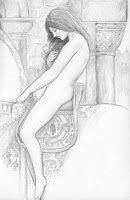[in Polish]

We dziele zatytułowanym 'Wspomnienia Mojej Młodości' (Lwów, zabór austriacki, AD 1895) autor Henryk Olechnowicz Stecki herbu Radwan załączył anegdotę o swoim wuju generale hrabim Krasińskim herbu Ślepowron i generale Tomaszu Lubieńskim herbu Pomian,

którą tutaj w całości załączam:
[29 anegdota, str 226]
''Mój wuj, jenerał [Wincenty] hr. Krasiński, miał w jednym z salonów swego pałacu w Warszawie kilka pokojów, przedstawiających bitwy, w których uczestniczył.
Jeden z nich, bardzo piękny, na obstalunek robiony przez [Horacego] Verneta, wyobraża bitwę pod Samosiera*; wiadomo, że ten wąwóz trudny do wzięcia, zdobyty był przez polskie legiony, wszystkie główniejsze osobistości są tam portretowane, zapomniano o jenerale Tomaszu Lubieńskim, który tam jednak grał wybitną rolę, natomiast na pierwszym planie siedzi na białym koniu jenerał Krasiński, który podczas tej pamiętnej bitwy tam nie był, bo znajdował się ze swoim oddziałem na innej stronie.[1]
Kiedyśmy raz byli na proszonym większym obiedzie u mego wuja, nim otworzono drzwi do jadalnej sali, goście siedzieli w pomienionym salonie, a jenerał Lubieński przypatrywał się kolejno obrazom.
Stal właśnie przed Samosiera, kiedy gospodarz przystąpił do niego i powiedział:
- Dziwna rzecz, jenerale, ze malarz ciebie nie odmalował.
- Dostateczny dla mnie zaszczyt, żem tam był.- opowiedział Lubieński.
Krasiński poczerwieniał i odszedł.
Stałem obok nich w czasie tej rozmowy.''
Poniżej obraz o którym panowie 'jenerałowie' rozmawiali.

Mości Olechnowicz Stecki nie raz jeszcze zagości na blogu, mam nadzieje, bo zaraźliwe zło z Wuhan szaleje.
Valete
*pisownia orginalna
[1] szef polskiego regimentu szwolezerow gwardii Wincenty Krasiński był przy Napoleonie ale faktycznie w szarzy nie brał udziału.

 in his
in his 





















































